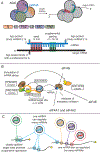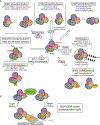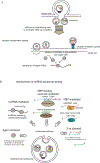Regulation of microRNA function in animals
- PMID: 30108335
- PMCID: PMC6546304
- DOI: 10.1038/s41580-018-0045-7
Regulation of microRNA function in animals
Abstract
Since their serendipitous discovery in nematodes, microRNAs (miRNAs) have emerged as key regulators of biological processes in animals. These small RNAs form complex networks that regulate cell differentiation, development and homeostasis. Deregulation of miRNA function is associated with an increasing number of human diseases, particularly cancer. Recent discoveries have expanded our understanding of the control of miRNA function. Here, we review the mechanisms that modulate miRNA activity, stability and cellular localization through alternative processing and maturation, sequence editing, post-translational modifications of Argonaute proteins, viral factors, transport from the cytoplasm and regulation of miRNA-target interactions. We conclude by discussing intriguing, unresolved research questions.
Conflict of interest statement
Competing interests
The authors declare no competing interests.
Figures









References
-
- Jonas S & Izaurralde E Towards a molecular understandingof microRNA-mediated gene silencing. Nat. Rev. Genet 16, 421–433 (2015). - PubMed
-
- Lee RC, Feinbaum RL & Ambros V The C. elegans heterochronic gene lin-4 encodes small RNAs with antisense complementarity to lin-14. Cell 75, 843–854 (1993). - PubMed
-
- Wightman B, Ha I & Ruvkun G Posttranscriptional regulation of the heterochronic gene lin-14 by lin-4 mediates temporal pattern formation in C. elegans. Cell 75, 855–862 (1993). - PubMed
-
- Pasquinelli AE et al. Conservation of the sequence and temporal expression of let-7 heterochronic regulatory RNA. Nature 408, 86–89 (2000). - PubMed
Publication types
MeSH terms
Substances
Grants and funding
LinkOut - more resources
Full Text Sources
Other Literature Sources
Medical

